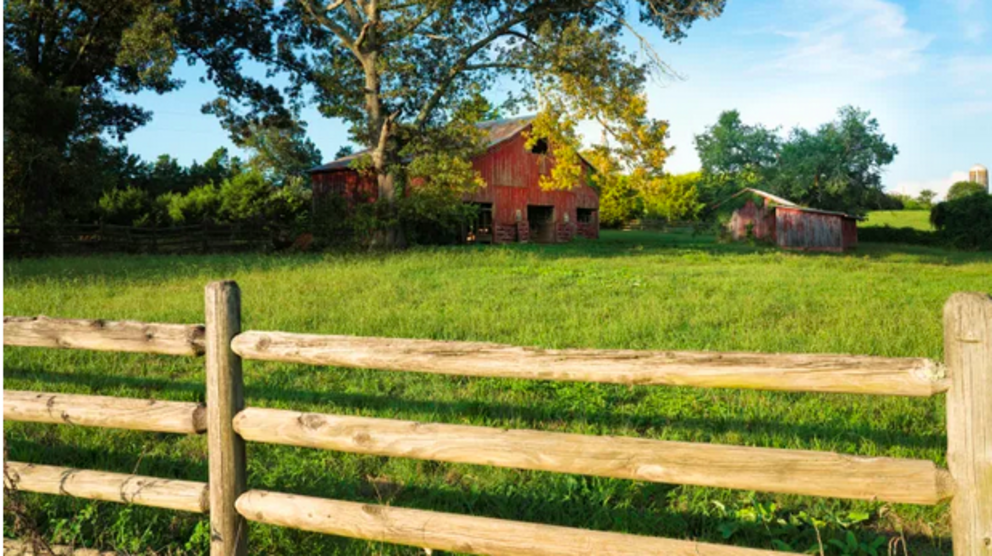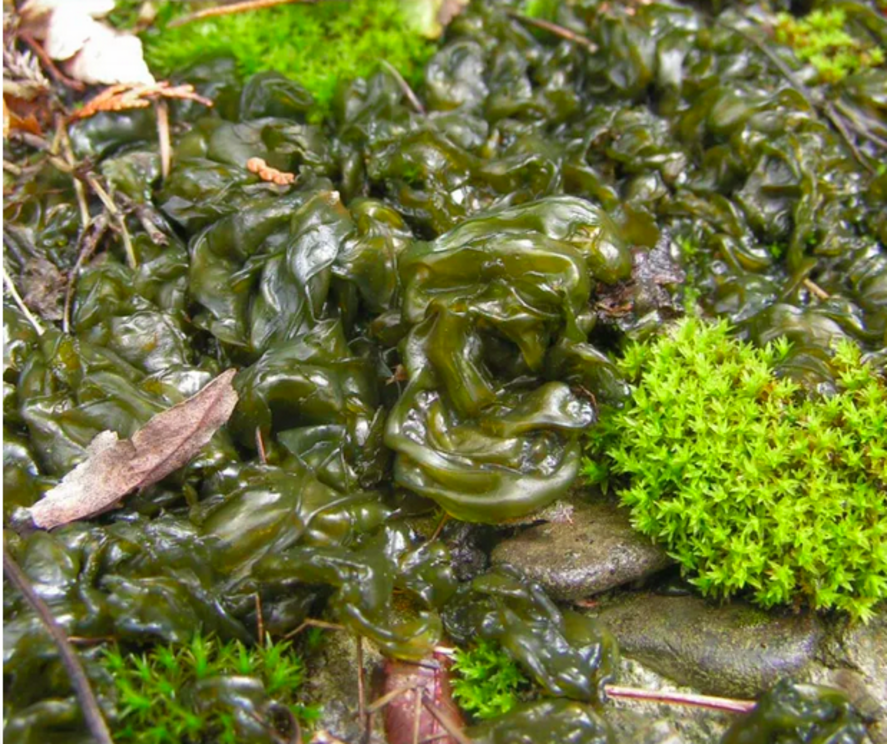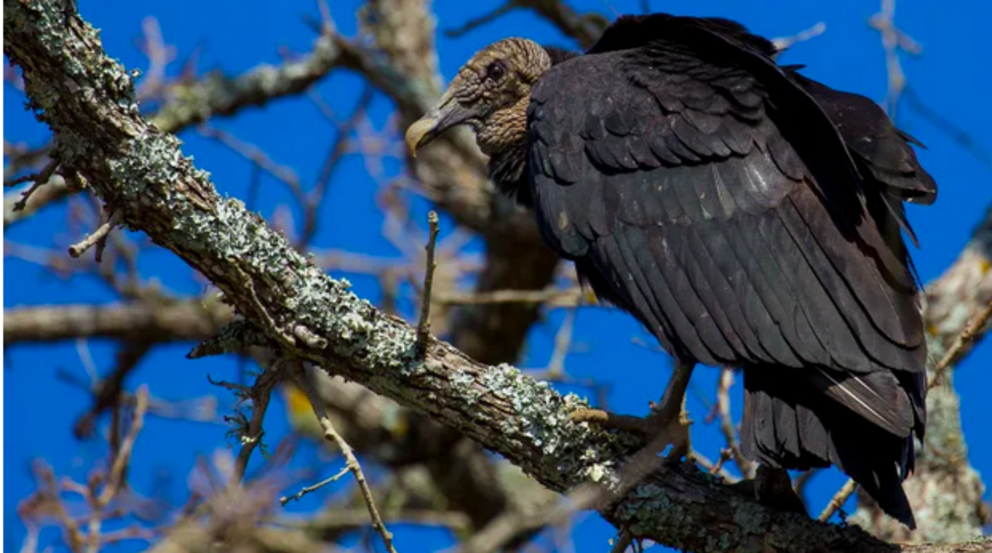Kentucky Meat Shower of 1876
The morning of Friday, March 3, 1876, dawned sunny and cloudless over Olympian Springs in northeastern Kentucky. A light breeze tickled the fields of the Crouch family farm as Mrs. Crouch made soap in the yard. Then, shortly before noon, something unexpected started tumbling from the skies.

Meat not to scale. / (Sky) Yuko Yamada/Moment/Getty Images; (Barn) Westend61/Westend61/Getty Images; (Meat) JDawnInk/DigitalVision Vectors/GettyImages
“Why, grandma, it’s snowing!” said Mrs. Crouch’s preteen grandson, Allen. But what pummeled the property for the next few minutes wasn’t snowflakes. They were gristly, oozing chunks of flesh—some as long as Mrs. Crouch’s hand.
For one horrible moment, as she later told a reporter, Mrs. Crouch considered the possibility that her “husband and son, who were away, had been torn to pieces and their remains were being brought home … by the wind.”
Thankfully, that hadn’t happened. So what had?
Am-ooze Bouche
It didn’t take long for news of the mystery meat to spread across the nation. “Flesh Descending in a Shower,” read a New York Times headline the following week. The New York Herald upped the ante by sending a correspondent from Louisville to investigate the matter.
The reporter, unnamed in the Herald, bounded around town gleaning details about the incident from all manner of residents. Chief among them were the Crouches themselves. Mrs. Crouch had bolted inside soon after the shower began, but she guessed that at least half a bushel (4 gallons) of meaty bits had fallen. When Mr. Crouch returned home later that day, he surveyed the carnage, which affected roughly an acre of land. The fences were flecked with tissue and stained with what looked like blood; thorny briers bore gobs of flesh like Christmas trees from hell.
The gory horror of the scene was completely lost on the Crouches’ hogs, chickens, cat, and dog, all of whom “had been eating [the meat] freely, and seemed to like it well,” according to Mrs. Crouch. (The dog did suspiciously fall ill sometime later that month.)

No grisly stains on this fence. / Marcia Straub/Moment/Getty Images
Mr. Crouch collected a number of samples and handed some off to Olympian Springs proprietor Harrison Gill, who preserved them in alcohol. Other chunks ended up in the mouths of dauntless locals—like 27-year-old butcher L.C. “Friz” Frisbe in the nearby city of Mount Sterling.
“Several persons … told me it was a dangerous experiment, but I told them my constitution could stand as much of it as a rooster’s or a cat’s,” Frisbe told the Herald reporter, their conversation soundtracked by the steady snore of a bone saw and occasional thwack of a cleaver. But even steel-stomached Friz had decided to spit out the meat “after chewing it a little,” perhaps because “a kind of milky, watery fluid oozed out of it,” he said. Though he likened its appearance to mutton and its texture to veal or lamb, he couldn’t place the taste or odor.
A merchant named Joe Jordan also spat out his specimen, which smelled like a dead body and leached “brown mucous.” Like Friz, Reverend J.R. Nichols compared the meat to mutton, while C.J. Craig claimed it looked like “pounded beefsteak.” Benjamin Franklin Ellington, a trapper, swore it was bear meat.
The Herald correspondent even tried to bribe an Irish railroad worker, Jimmy Welsh, to sample a bite. Welsh agreed to do it for a dollar, but kept finding ways to put off the deed. First he asked for side dishes, then demanded whiskey, and finally claimed he just wasn’t hungry. After the correspondent raised the reward to $3, Welsh abruptly remembered that he couldn’t eat meat because it was Lent.
If butchers, preachers, and railroad workers couldn’t solve the mystery, maybe scientists could.
Game of Theories
According to one rumor, the whole thing was a hoax staged by Mrs. Crouch to frighten her husband into selling their farm. The Crouches had a good laugh when the Herald reporter relayed this explanation: Apparently, Mr. Crouch had already wanted to sell the farm. Another amateur theorist posited, per the Herald, that “the meat might have fallen from the lunch basket of a passing balloonist.”
As samples made their way to laboratories, slightly less fanciful theories began to emerge. Chemist J. Lawrence Smith told The New York Times that he believed the shower was dried frog spawn “transported from the ponds and swampy grounds by currents of winds.” To some people who’d seen the debris in all its gutsy glory, this notion was about as hard to swallow as the meat itself.

Nostoc in a wet environment. / YAMAMAYA, Wikimedia Commons // CC BY-SA 1.0
In the weekly medical journal The Louisville Medical News, Leopold Brandeis suggested that the substance was Nostoc—a type of cyanobacteria that expands into snotty, gelatinous clumps when there’s excessive moisture on the ground. Because this often happens after rain, legend had it that Nostoc rained down, too. Brandeis, for his part, just thought the wind had borne some along to rural Kentucky.
But the most plausible theory—then and now—is that the meat spewed forth from the beaks of vultures soaring overhead. Turkey vultures and black vultures, both native to Kentucky, sometimes vomit when threatened. Not only does their extremely acidic chunder function as a weapon of sorts, but an empty stomach might also help them make a quicker getaway.
“I have always thought there were big holes in that theory because Mrs. Crouch said the meat fell from a clear blue sky and surely she would have noticed a flock of vultures of a quantity needed to fill a football-sized field with meat by vomiting,” Kurt Gohde, an art professor at Kentucky’s Transylvania University who’s researched the meat shower extensively, tells Mental Floss.

A black vulture minding its own business. / John Janecka/500px/Getty Images
Gohde has since come around after learning more about black vultures—namely, that they’ve been known to fly at a 20,000-foot altitude in flocks (or kettles) of dozens or even hundreds, and they can scarf down pound after pound of flesh in mere minutes. In other words, it’s totally possible that the vultures were flying high enough that Mrs. Crouch didn’t see them, and that the kettle was large enough to regurgitate half a bushel of bits or more. This theory also accounts for the lack of consistency in everyone’s descriptions of what Gohde calls “the meatrain.” Even scientists couldn’t agree on whether it was muscle, cartilage, fat, or something else.
“Those vultures would have had different meals in their stomachs and quite likely there were a handful of different meats mixed into the shower of flesh,” he explains. “Meats of various dead animals soaked in the acidic brine of vulture stomach digestive fluids. That sounds like a horrible thing to eat!” Bully for Jimmy Welsh.
The Electric Jelly Bean Taste Test
Gohde’s study of the Kentucky Meat Shower wasn’t confined to researching vulture habits. In 2004, as Atlas Obscura reports, he happened to unearth a surviving chunk buried in storage at Transylvania University. So he had it genetically tested.
“The tests didn’t reveal the animal and didn’t reveal much else either,” he says. “The fluid it was suspended in was an alcohol preservation fluid. The cork was estimated to have been only about 40 years old at the time and it was assumed that was when the fluid was probably swapped out (from what may have been formaldehyde) for alcohol.” (These days, the chunk is tucked safely away in an apothecary cabinet at TU’s Monroe Moosnick Medical and Science Museum.)

The surviving sample from the shower. / Kurt Gohde
Without genetic analysis to nail down exactly what one vulture may have upchucked that fateful March day, Gohde enlisted a Cincinnati taste lab to create jelly beans based on the sample’s flavor compounds. He described the flavor of the treat as “strong enough that I would have immediately spit out any meat with that taste,” with a lingering chemical aftertaste. In 2007, he solicited feedback from other taste-testers at Mount Sterling’s annual fall festival Court Days.
Many compared the flavor to ham; “lamb that has started to turn” and “pre-cooked bacon” also came up. Gohde mused that the preservatives in pre-cooked bacon products might “add a flavor to the bacon that somewhat matches the chemical taste I sensed myself when I tasted the jelly beans.”
“My absolute favorite was ‘strawberry porkchop’ because that is what was guessed the instant a large man with a beard put it into his mouth. He was certain,” recalls Gohde, who’d never heard of such a dish. “I prefer to just let that remain as a sort of wonder in my mind so I haven't looked it up at all.”
Gohde is happy to leave the matter of the Kentucky Meat Shower unsettled, too—however plausible the vulture vomit theory seems.
“I don’t know if I will ever think of it as a closed case,” he says. “I prefer to think of it as a mystery that was left open because it happened at a time when people didn’t need to solve all things.”
